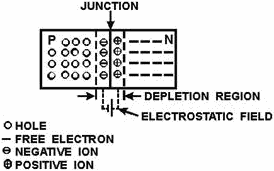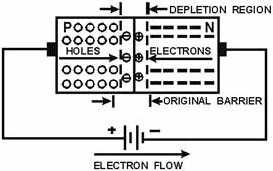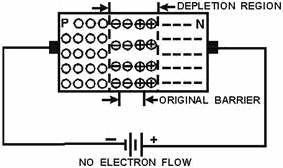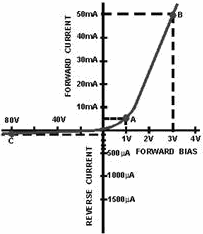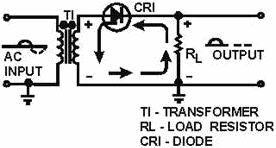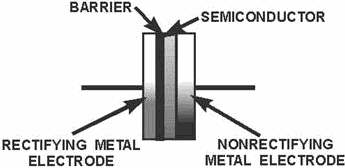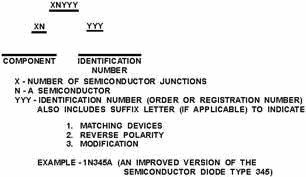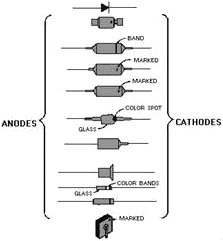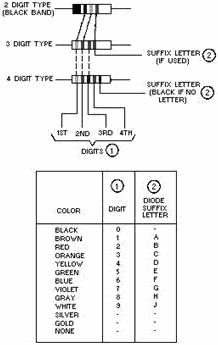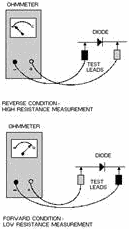Module 7 - Introduction to Solid-State Devices and Power Supplies |
||||||||||||||||||||||||||||||||||||||||||||||||||
|
Module 7 − Introduction to Solid−State Devices and Power Supplies
Pages i , 1−1, 1−11, 1−21, 1−31, 1−41, 2−1, 2−11, 2−21, 2−31, 2−41, 2−51, 3−1, 3−11, 3−21, 3−31, 3−41, 3−51, 4−1 to 4−10, 4−11, 4−21, 4−31, 4−41, 4−51, Index
forWARD BIAS is an external voltage that is applied to a PN junction to reduce its barrier and, therefore, aid current flow through the junction. To accomplish this function, the external voltage is connected so that it opposes the electrostatic field of the junction.
REVERSE BIAS is an external voltage that is connected across a PN junction so that its voltage aids the junction and, thereby, offers a high resistance to the current flow through the junction.
1-41
The PN JUNCTION has a unique ability to offer very little resistance to current flow in the forward-bias direction, but maximum resistance to current flow when reverse biased. For this reason, the PN junction is commonly used as a diode to convert ac to dc.
The PN JUNCTION'S APPLICATION expands many different areas-from a simple voltage protection device to an amplifying diode. Two of the most commonly used applications for the PN junction are the Signal DIODE (mixing, detecting, and switching signals) and the RECTIFYING DIODE (converting ac to dc).
1-42
The METALLIC RECTIFIER or dry-disc rectifier is a metal-to-semiconductor device that acts just like a diode in that it permits current to flow more readily in one direction than the other. Metallic rectifiers are used in many applications where a relatively large amount of power is required.
DIODE Characteristics is the information supplied by manufacturers on different types of diodes, either in their manuals or on specification sheets.
DIODE RATINGS are the limiting value of operating conditions of a diode. Operation of the diode outside of its operating limits could damage the diode. Diodes are generally rated for: Maximum AVERAGE forWARD CURRENT, PEAK RECURRENT forWARD CURRENT, Maximum SURGE CURRENT, and PEAK REVERSE Voltage.
1-43 The SEMICONDUCTOR IDENTIFICATION System is an alphanumerical code used to distinguish one semiconductor from another. It is used for diodes, transistors, and many other special semiconductor devices.
DIODE MARKINGS are letters and symbols placed on the diode by manufacturers to distinguish one end of the diode from the other. In some cases, an unusual shape or the addition of color code bands is used to distinguish the cathode from the anode.
1-44 The STANDARD DIODE COLOR Code System serves two purposes when it is used: (1) it identifies the cathode end of the diode, and (2) it also serves to identify the diode by number.
DIODE Maintenance is the procedures or methods used to keep a diode in good operating condition. To prevent diode damage, you should observe standard diode safety precautions and ensure that diodes are not subjected to heat, current overloads, and excessively high operating voltages.
TESTING a DIODE can be accomplished by using an ohmmeter, the substitution method, or a dynamic diode tester. The most convenient and quickest way of testing a diode is with an ohmmeter.
1-45
Answers to Questions Q1. Through Q36.
A1. An electronic device that operates by virtue of the movement of electrons within a solid piece of semiconductor material.
A2. It is the decrease in a semiconductor's resistance as temperature rises.
A3. Space systems, computers, and data processing equipment.
A4. The electron tube requires filament or heater voltage, whereas the semiconductor device does not; consequently, no power input is spent by the semiconductor for conduction.
A5. Anything that occupies space and has weight. Solid, liquid, and gas.
A6. The atom.
A7. Electrons-negative, protons-positive, and neutrons-neutral.
A8. The valence shell.
A9. Quanta.
A10. a negatively charged atom having more than its normal amount of electrons.
A11. The energy levels of an atom in a solid group together to form energy bands, whereas the isolated atom does not.
A12. The width of the forbidden band.
A13. The number of electrons in the valence shell.
A14. Covalent bonding.
1-46 A15. Electron flow and hole flow.
A16. Intrinsic.
A17. P-type crystal.
A18. Electrons.
A19. To convert alternating current into direct current.
A20. Toward the arrow.
A21. Point-contact.
A22. Holes.
A23. N-type material.
A24. Depletion region.
A25. Negative.
A26. Forward.
A27. Any device that draws current. A28. a pulsating dc voltage.
A29. Metallic rectifier.
A30. Forward bias.
A31. a characteristic curve.
A32. They are the limiting values of operating conditions outside which operations could cause diode damage.
A33. a semiconductor.
A34. 1N368.
A35. Heat.
A36. The diode is open or has a high-forward resistance.
1-47
|
||||||||||||||||||||||||||||||||||||||||||||||||||
